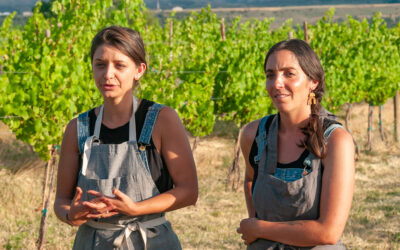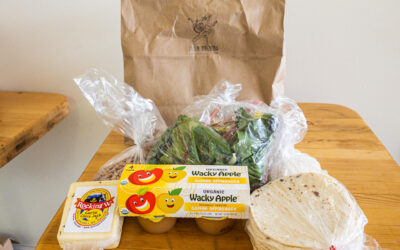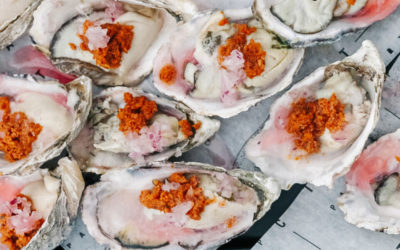Monica Wiitanen had no thoughts about opening a bakery when she first started making artisan breads 20 years ago.
At the time, Wiitanen and her husband, now based in Paonia, Colo., were living in Michigan.
“A friend came by with a specialty-bread cookbook, and it intrigued me,” she said.
Eventually she formed an idea: why not start an artisan bread-making business out of her home?
“I was ready to do it. It kept growing from there,” she said.
The idea came to fruition after the couple moved to Colorado in 1996 and bought ten acres of land in Paonia, founding Small Potatoes farm.
“I worked to get our Colorado Cottage Foods Act signed into law (and passed in 2012), which allows any resident of Colorado to make certain low-risk foods in their home kitchens as long as they sell directly to customers,” Wiitanen said.
Her doughs are mixed in a 20-quart Hobart mixer and then shaped or braided by hand. They are made with the finest ingredients available including rye, white, buckwheat, spelt and whole wheat flours.
Some of the wheat she gets directly from farmers in the San Luis Valley, and she grinds some of those flours herself.
Customers also have the choice of Finnish, garlic, and pumpernickel breads, sweet breads, bagels with caramelized onions, Fougasse (small loaves with lots of olive oil), fruit-filled pastries, cookies and brownies. Some of the items are gluten restricted, but she doesn’t label them “free.”
“The FDA recently set a standard on those levels,” Wiitanen explained. “The product must be tested in a lab before it can be called ‘free.’”
The flavors are enhanced by the baking process, which is done in a traditional, outdoor brick oven.
“It was specially-built by an architect named Philip Salembier here eight years ago. He thought it would be a great project,” she said.
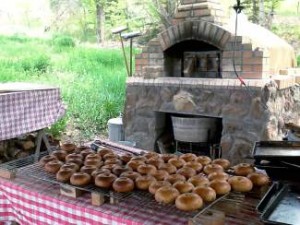 The oven came together after Wiitanen and Salembier ordered plans from Ovencrafters.
The oven came together after Wiitanen and Salembier ordered plans from Ovencrafters.
“It probably came from an old French design,” Salembier said. “Bread has been baked in brick ovens since Roman times. The hearth is of fire brick and the rest of the cavity is a good quality red brick — same as you’d use in houses. It sits on a base of cinder blocks. Concrete was used for pad under the hearth, and there is an insulating type of concrete surrounding it. But,” he added, “as an architect, I couldn’t help but play around with the plans a bit.”
Brick oven baking takes experience.
“It’s not like turning an oven on to 350. You build heat into a mass and then pull it out. There are all sorts of different heats. The essence is thermodynamics: if you put heat into something, it will flow out into a cooler space,” Salembier said. “Some days we battle the oven. There is more heat coming down from the arch above, or sometimes the back is hotter, and we need to juggle things around.”
He continued, “On occasion, we’ve had to place loose bricks inside the oven to pull heat out. And we still ‘thunk’ bread on the bottom to make sure it’s done. You don’t get too far away from the oven once something is inside.”
A brick oven can reach temperatures as high as 700 degrees.
Wiitanen said, “It’s a retained heat oven. First you build fire on the hearth. The purpose is to get heat into bricks, walls, and arch and penetrate them. After you sweep the ashes out there’s all this heat left over, and it stays.”
The oven slowly cools over time, and she plans her baked-goods orders accordingly.
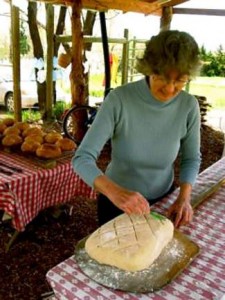 “Pizza dough goes in first. It needs high temps and it cooks quickly. Then I put in some light sourdough breads that can take 500 degrees. After that, I do the sweetbreads, muffins and cookies because anything with sugar in it will scorch if the temps are over 400,” she said. “Danish pastries are the last. It’s really a matter of how much energy you have to keep going; the oven always has more!”
“Pizza dough goes in first. It needs high temps and it cooks quickly. Then I put in some light sourdough breads that can take 500 degrees. After that, I do the sweetbreads, muffins and cookies because anything with sugar in it will scorch if the temps are over 400,” she said. “Danish pastries are the last. It’s really a matter of how much energy you have to keep going; the oven always has more!”
Wiitanen can bake for hours with one firing, as the temperatures cascade or fall gradually.
“It’s like a puzzle to figure out how to mix and bake different things in a timely way,” she said.
Wiitanen is so tuned into her brick oven that she doesn’t use a timer.
“I just know when to check. There’s a real intuition behind it,” she said.
Sometimes she realizes a baked good is done right as a timer goes off from someone else who is helping in the kitchen.
Wiitanen starts preparing days before firing the brick oven.
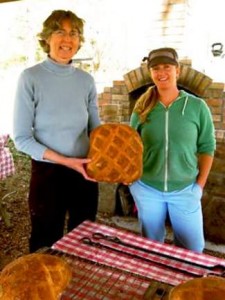 “This week, I fed a sourdough on Tuesday evening so it could be built (increased) Wednesday morning. The dough was mixed Wednesday afternoon, shaped, and put into baskets in the freezer overnight so it could be baked Thursday morning. At 6 a.m., I was mixing other doughs that could be baked after the sourdough,” she said.
“This week, I fed a sourdough on Tuesday evening so it could be built (increased) Wednesday morning. The dough was mixed Wednesday afternoon, shaped, and put into baskets in the freezer overnight so it could be baked Thursday morning. At 6 a.m., I was mixing other doughs that could be baked after the sourdough,” she said.
Produce is sold at Small Potatoes Farm, too. Farmer Scott Horner offers potatoes, beets, greens, peppers, cucumber and more.
An email goes out at the beginning of each week with a list to let people know what’s available and what it costs.
Some people do stop by during regular hours just to see if there is any bread left, though. Since the brick oven is outdoors, there is no doubt those wonderful smells tend to linger, drawing them in.


